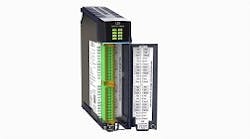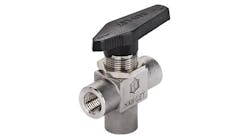Jim Montague is the executive editor for Control. Email him at [email protected].
Everyone needs to update their skills now and again, and every machine eventually needs a revamp. However, it's rare for a 70-year-old technology to gain so many new capabilities that it can leapfrog present competition, and rarer still for a builder to be imaginative and flexible enough to pull off the design and construction of a whole new line of machines based on these innovations.
Still, that's exactly what Beckwood Press Co. has accomplished over the past few years with its Triform sheet hydroforming presses. Located in Fenton, Missouri., near St. Louis, the 38-year-old company builds hydraulic presses and automation systems, which are custom-made to meet the individual needs of its users.
"Beckwood was founded in 1976," says Ryan Pendleton, Beckwood's sales and marketing manager. "For years, we were exclusively a supplier of custom hydraulic presses and equipment. In the last decade, we've expanded our product offerings beyond custom hydraulic presses. Today, Beckwood customers benefit not only from our hydraulic press solutions, engineered for their specific application, but also from our line of Triform sheet hydroforming presses, stretch forming presses, forming simulation software, as well as a variety of automation offerings, including robotics and quick die-change equipment.
Also Read: The Lowdown on Hydraulics
Applications for Beckwood's presses include forming, drawing, hot forming, compression molding, punching and blanking, stamping, powder compacting, straightening, sheet hydroforming and more. Its customers range from multinational corporations to smaller manufacturers in industries that include aerospace and defense, oil, gas and energy, construction and off-road vehicles, agriculture, automotive and appliances.
"Our philosophy revolves around manufacturing high-quality, high-performance manufacturing solutions engineered to the needs of the specific customer," explains Pendleton. "Each Beckwood structure is put through a rigorous finite element analysis (FEA) and is designed for infinite life. Beckwood products are also subject to meticulous quality control procedures to ensure that each system is ready to perform when it hits the customer's floor."
Beckwood Press' Triform sheet hydroforming press has 1,225 tons of lower punch force, 10,000 psi maximum chamber and a 25-inch diameter forming area. It uses two 125-hp motors, hydraulic pumps, is controlled by CNC and PLCs, and can achieve forming pressure control of ±1% of full scale and forming position control of ±0.002 inches.
Beckwood's focus on customization has been good news for its customers, who can routinely request and receive wider, deeper press designs and specialized functions. So when an Oklahoma-based aerospace parts manufacturer got tired of fixing and adjusting its ancient Cincinnati hydroforming machine, it knew Beckwood could help it to develop a modern, more-capable version. The company partnered with Beckwood to design and build a prototype with modern controls and technology. It became the template for Beckwood's Triform Sheet Hydroforming line of presses.
Hydraulic hydroforming was invented in the late 1940s, and basically pumps hydraulic fluid into a "rubber" bladder at high pressure to force or draw sheet metal onto a tool to create desired shapes. These machines were made until the 1970s, and many of these aging presses are still in use today. Their main advantage is an ability to form parts using inexpensive tooling. This is because the diaphragm acts as a universal die half, conforming to any shape within the forming chamber. The process can also form parts consistently without wrinkling sheet metal or damaging its finish, which can prevent a lot of wasted material and save a lot of time on post-production work.
However, these traditional machines typically required numerous screws to be adjusted to specific distances via a big cam on the front, so the machine's trip switches could make the right pressure changes at the right times during each cycle. In addition, these difficulties were compounded by the steel tooling forms used in traditional hydroforming, which cost thousands of dollars to machine, finish and maintain. Eventually, epoxy forms were developed and used, but they were also time-consuming and costly to mold, pour and produce.
To help customers like its user in Oklahoma, Beckwood completed and launched its Triform machines in 2008. These machines include two main types. The first is fluid cell, which uses only the downward action of the bladder to form sheet metal around or into one tool. The second type is deep draw, which uses the same principle at work in the fluid cell process, but it also features a hydraulic punch cylinder that raises the tool into the bladder during the forming process.
The fluid cell presses range from the 16-5BD press with a 16-inch diameter forming area and 5,000 psi maximum chamber pressure up to its 2496-5BD press with a 24 x 96-inch forming area and 5,000 psi maximum chamber pressure. Its deep draw machines range from its 12-10-7BD press with 565 tons of force, 12-inch diameter forming area, 7-inch draw and 10,000 psi maximum chamber pressure up to its 32-10-12SC press with 4,020 tons of force, 32-inch forming area, 12-inch draw and 10,000 psi maximum chamber pressure.
For example Steelville Manufacturing (www.steelvillemfg.com) in Steelville, Missouri, uses a Triform 24-5BD and its 24-in. diameter forming area and 5,000 psi to save time on making parts for Boeing, Lockheed Martin and Sikorsky.
"Before the Triform, we were often forming flanges and other part geometries in a press brake," says Joseph Dust, an engineer at Steelville, who managed Triform's integration. "We would also pre-form certain parts by forming them into stacked rubber against a male or female die before finishing them in a second operation that involved a traditional press with male/female tooling. With Triform, we bypass those processes and form our parts more quickly and efficiently. The overall time required for the completion of our form tools has been cut in half."
Beckwood reports its press systems use high-quality components from leaders in the industry. Hydraulic pumps are typically from Bosch Rexroth or Parker Hannifin, while Beckwood's go-to control platform is Allen Bradley from Rockwell Automation.
The deep draw presses typically achieve forming pressure control of ±1-2% of full scale and forming position control of ±0.002 to ±0.005 inches. In addition, the presses use proprietary Triform forming software and can make up to 30 pressure changes during the cycle for one part, which enables more accurate production of more sophisticated parts. Also, the presses have Ethernet-based, virtual private network (VPN) communications that enable Beckwood to perform remote monitoring and diagnostics of its customers' machine with their permission.
"Recently, Beckwood began employing technologies aimed at increasing machine intelligence," adds Pendleton. "These include our Pre-Preventive Maintenance (PPM) system that monitors the health status of various press systems. PPM reports on its press' performance, faults, safety system status, etc. The reporting can be delivered in real time and sent direct from the press to key user personnel and to Beckwood's technical service team via email."
In recent years, Triform customers have experimented with and successfully applied high-strength 3D-printed tooling, such as Stratasys' Ultem or polycarbonate thermoplastics, which are less costly and can be made much faster than traditional tools. It also uses ESI's Pam-Stamp 2G software to simulate the forming process and find the optimum form block and blank design. Likewise, Steelville is employing 3D-printed form blocks, which it can use on its Triform machine, and bypass its own machining centers to save even more time.
"These three technologies are revolutionizing forming operations," says Jeffrey Debus, Beckwood's president. "Companies outfitted with these systems can go from a part drawing to a finished, net shape part in less than 24 hours at a fraction of the cost of traditional forming methods. This requires a fundamental shift in thinking, away from a bygone era that included complex tooling, days if not weeks of process development time and an overall part development cost that handicapped many projects. From an idea to a finished part in a matter of hours. That's the future."




